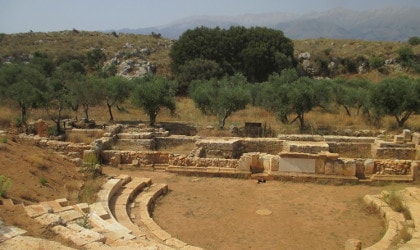Archaeologist Anaya Sarpaki explains in On the Olive Routes that olive trees have existed longer than modern humans. For example, wild olive leaf fossils from the Greek island of Evia date back 23 million years. At Santorini, 37,000 to 50,000 year old leaf fossils from the olive species Olea europaea have been discovered in the volcanic crater.
Humans began to use olive oil in the Middle Neolithic Period, as far back as 4500 BC, according to traces in a bowl found in Gerani Cave in Rethymno, Crete. Anaya Sarpaki and Nikos Michelakis discuss the importance of olive oil in Minoan Crete, the source of “the first written records and art creations about” olive trees and olive oil “in the world.” The olive oil traces found in Rethymno about 6500 years ago imply that olive oil was already part of the Cretan diet then, and by 2000 BC the Cretans seem to have begun “to exploit the tree systematically, producing olive oil as we know it today” (On the Olive Routes 6).
Sarpaki and Michelakis point out that ideograms on clay tablets in the Linear A and B scripts show that olive oil production and consumption were important in Minoan life by 1700 BC, with olive oil exported from Crete to other parts of Greece and abroad at least by the 14th century BC, and extensive exports beyond Greece after the 8th century BC. Olive oil was not only eaten, but also used to preserve foods and as a medicine, a body rub, a lubricant, a perfume, “in religious ceremonies,…to produce light…in witchcraft and the care of the dead” (On the Olive Routes 6-7).

From Minoan frescoes and jars to Homer’s Iliad and Odyssey, ancient mythology, Aesop’s fables, Solon’s laws, Aristotle’s writings, the laws and games of classical Greece, and religion past and present, the olive tree and its oil have been prominent. (See On the Olive Routes for details.)
A famous story explains the name of the city of Athens this way: the goddess Athena competed with the god Poseidon to see who would produce the most impressive gift for human beings. While Poseidon offered either a salt water spring or a horse (depending on the version of the story), Athena produced an olive tree. After the olive tree was judged more valuable, the city of Athens received its name (actually still “Athina” in Greek today) and its patron goddess. Later, olive wreaths were awarded as prizes at the Olympic Games. Athletes coated their bodies with olive oil, and Panathenaic Games winners were awarded many large, valuable jars of olive oil.
A crucial element of Minoan and Mycenaean commerce and exports, olive cultivation and olive oil use continued to spread around the Mediterranean area during the years of the Roman Empire. Both the export and domestic use of olive oil remained important during the time of the Byzantine Empire, as well as afterwards.
Olive oil has also played a key role in the ceremonies of the Greek Orthodox Church throughout the centuries, for example in the baptismal font and on the baptized child, in holy myrrh, in oil lamps, and during special blessings. Olive branches are still used when priests bless schoolchildren at the beginning of the school year and in the Palm Sunday processions in Cretan villages.



